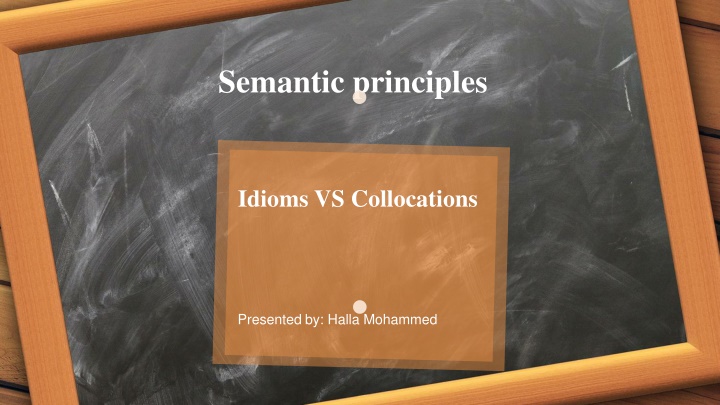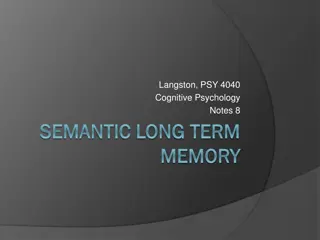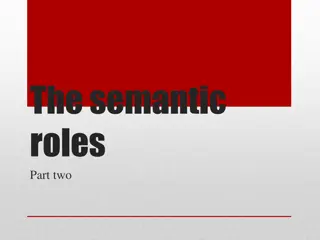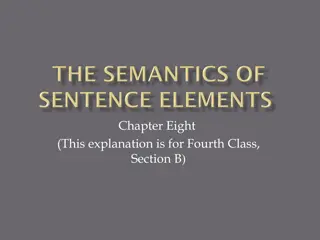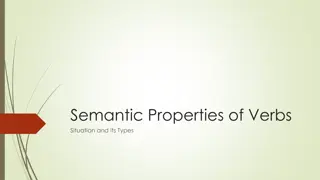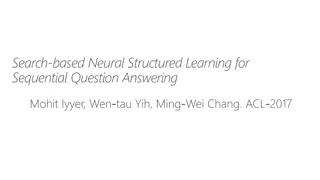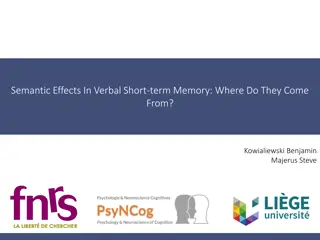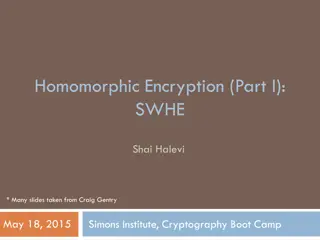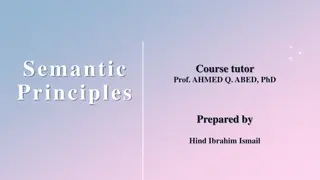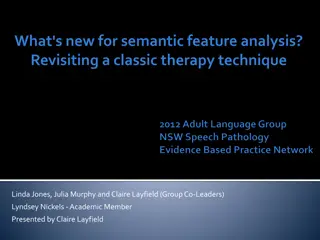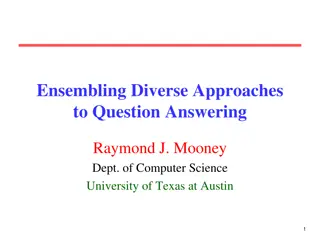Semantic principles
Idioms and collocations are essential aspects of language use, each with distinct characteristics that impact translation and communication. Idioms are fixed expressions with unique meanings, while collocations involve words that often co-occur naturally. Translators must navigate these differences to convey accurate messages across languages.
Download Presentation

Please find below an Image/Link to download the presentation.
The content on the website is provided AS IS for your information and personal use only. It may not be sold, licensed, or shared on other websites without obtaining consent from the author.If you encounter any issues during the download, it is possible that the publisher has removed the file from their server.
You are allowed to download the files provided on this website for personal or commercial use, subject to the condition that they are used lawfully. All files are the property of their respective owners.
The content on the website is provided AS IS for your information and personal use only. It may not be sold, licensed, or shared on other websites without obtaining consent from the author.
E N D
Presentation Transcript
Semantic principles Idioms VS Collocations Presented by: Halla Mohammed
Idioms VS Collocation o Idioms: Unlike collocations, which are fairly flexible patterns of language which allow several variation in form , idioms allow no variation (Baker 1992: 63). Idioms like: to be yellow to get the wind up , cannot be respectively modified into something like to be red to get the storm up. Idiomatic expressions allow almost no variation in form under normal circumstances and present particular difficulties because they are restricted collocations which cannot normally be understood from the literal meaning of the words which make them up (Carter 1998: 65). language users and translators cannot rely on the open choice principle, that is to say, relying on the meanings of its components. Rather, they need to resort to the idiom principle by treating the idiomatic expression as one unit.
Examples about idioms: ST: When he was surrounded by the enemy, he showed the white feather and surrendered. When he heard the explosion, he had his heart in his mouth. ST: TT: , TT: , These idiomatic expressions, viz. To show the white feather, and to have your heart in your mouth cannot be understood without treating them as units. They are fear-related idioms meaning, to exhibit cowardice, and to be extremely afraid respectively.
Idioms VS Collocation o Collocations: Collocation means the tendency of two or more lexical items to co-occur together in certain contexts Adjectives like fast and quick, for instance, are synonyms as they share the sense of doing something at speed . However, the adjective fast collocates well with nouns like food and train, but not meal or shower. Collocations are language-specific, that is, what is considered as collocation cannot be taken for granted in another. Further, they are not governed by fixed rules. patterns of collocation are largely arbitrary and independent of meaning. This is so both within and across languages. The same degree of mismatch that can be observed when comparing the collocational patterns of synonyms and near-synonyms within the same language is evident in the collocational patterning of dictionary equivalents/near equivalents in two languages. (Baker1992:48)
Idioms VS Collocations o Collocations: In a direct link with translation, it is essential that translators while translating collocation give full consideration to the degree of predictability of lexical co-occurrence, that is, the degree of its markedness, as opposed to unmarkedness. Combinations like : for native speakers of Arabic. Similarly, combinations like bright face, bright idea, bright future, and so on are unmarked collocations as they sound natural for native speakers of English. Marked collocations, however, are unnatural combinations that are deliberately used by the speaker/writer to create new images (Baker 1992: 51). are labeled unmarked as they are natural combination
The following example quoted from Lubna Mahmd Ysns story (n.d.) (A Citizen s Fingerprint) ST: TT: The night swallows him so he delves ever deeper into the heart of silence. Who can, then, escape if the pain is densely settled inside the self and sadness penetrates the depths of the heart? His heart erodes; his limbs fall off; his voice gets torn away at the boundaries of time, yet no response comes. .. .. .. .. .. In this example, the original writer deliberately uses an unnatural combination (lit. the intestines of silence) to create a new image. So, it is an example of marked collocation. To reflect the same degree of markedness, the translators may exclude unmarked collocations, such as wall of silence or a vow of silence. In this regard, Trotter (2000: 351) rightly comments: Translation requires invariance in the markedness of collocates, rather than replacing abnormal usage in an original with normal usage in translation
The following example from Muhsin Al-Ramls story (2009: 29) (searching for a live heart). ST: TT: Take all of me, my flesh and my fat, he cries, impersonating the drunkard. He laughs and says , No, no, he didn t say that, for he had neither flesh nor fat. He was just a bag of skin and bones, drenched in sweat . .. .. ) ( , : The phrase (my flesh and my fat) is used in Arabic for emphasis to mean all or personally , thus it may be translated into an expression like body and soul, which is an expression used in English to mean completely . However, repeating the components of the phrase in the text many times, such as and the like, leaves us with no alternative but the literal translation Baker (1992: 72) rightly comments that translators should take into account the significance of the specific items which constitute the idiom, i.e., whether they are manipulated elsewhere in the source text or not.
Idioms VS Collocations Idioms Collocations An expression that cannot be understood from the meanings of its separate words but that has a separate meaning of its own. Means the tendency of two or more lexical items to co-occur together in certain contexts. Idiomatic expressions allow almost no variation in form under normal circumstances and present particular difficulties They are fairly flexible patterns of language which allow several variation in form. they are restricted collocations which cannot normally be understood from the literal meaning of the words which make them up (Carter 1998: 65). They are language-specific, that is, what is considered as collocation cannot be taken for granted in another. They are not governed by fixed rules Language users and translators cannot rely on the open choice principle, that is to say, relying on the meanings of its components. Rather, they need to resort to the Idiom principle by treating the idiomatic expression as one unit. In a direct link with translation, it is essential that translators while translating collocation give full consideration to the degree of predictability of lexical co-occurrence, that is, the degree of its markedness, as opposed to unmarkedness. Example: To get the wind up , To be yellow Example: Quick shower, Fast food
THANK YOU
